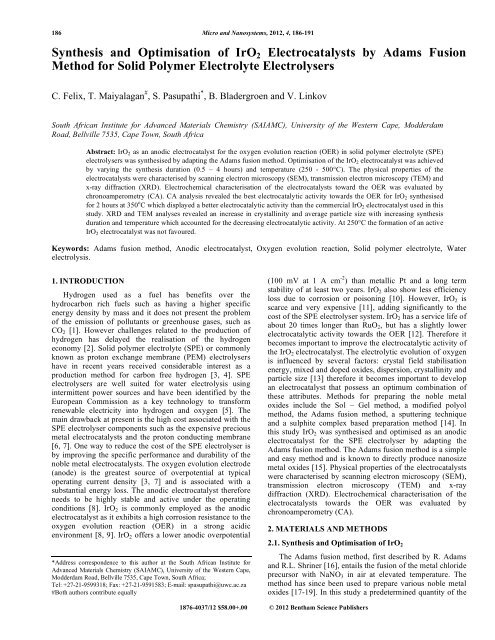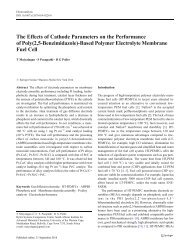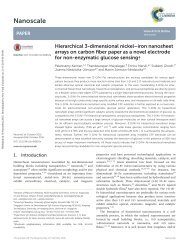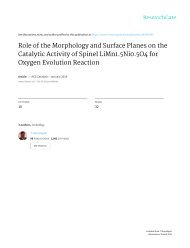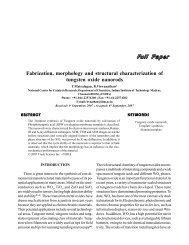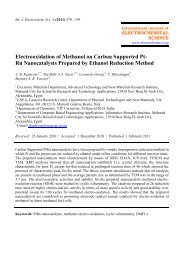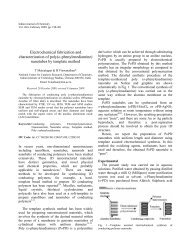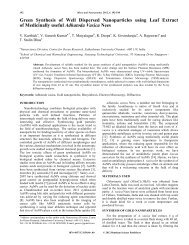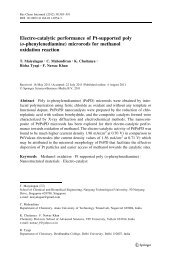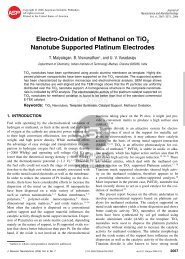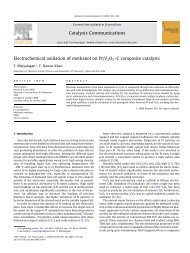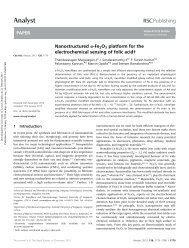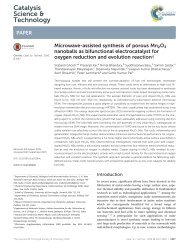Synthesis-and-Optimisation-of-IrO-2-Electrocatalysts-by-Adams-Fusion-Method-for-Solid-Polymer-Electrolyte-Electrolysers
You also want an ePaper? Increase the reach of your titles
YUMPU automatically turns print PDFs into web optimized ePapers that Google loves.
186 Micro <strong>and</strong> Nanosystems, 2012, 4, 186-191<br />
<strong>Synthesis</strong> <strong>and</strong> <strong>Optimisation</strong> <strong>of</strong> <strong>IrO</strong> 2 <strong>Electrocatalysts</strong> <strong>by</strong> <strong>Adams</strong> <strong>Fusion</strong><br />
<strong>Method</strong> <strong>for</strong> <strong>Solid</strong> <strong>Polymer</strong> <strong>Electrolyte</strong> <strong>Electrolysers</strong><br />
C. Felix, T. Maiyalagan # , S. Pasupathi * , B. Bladergroen <strong>and</strong> V. Linkov<br />
South African Institute <strong>for</strong> Advanced Materials Chemistry (SAIAMC), University <strong>of</strong> the Western Cape, Modderdam<br />
Road, Bellville 7535, Cape Town, South Africa<br />
Abstract: <strong>IrO</strong> 2 as an anodic electrocatalyst <strong>for</strong> the oxygen evolution reaction (OER) in solid polymer electrolyte (SPE)<br />
electrolysers was synthesised <strong>by</strong> adapting the <strong>Adams</strong> fusion method. <strong>Optimisation</strong> <strong>of</strong> the <strong>IrO</strong> 2 electrocatalyst was achieved<br />
<strong>by</strong> varying the synthesis duration (0.5 – 4 hours) <strong>and</strong> temperature (250 - 500°C). The physical properties <strong>of</strong> the<br />
electrocatalysts were characterised <strong>by</strong> scanning electron microscopy (SEM), transmission electron microscopy (TEM) <strong>and</strong><br />
x-ray diffraction (XRD). Electrochemical characterisation <strong>of</strong> the electrocatalysts toward the OER was evaluated <strong>by</strong><br />
chronoamperometry (CA). CA analysis revealed the best electrocatalytic activity towards the OER <strong>for</strong> <strong>IrO</strong> 2 synthesised<br />
<strong>for</strong> 2 hours at 350 o C which displayed a better electrocatalytic activity than the commercial <strong>IrO</strong> 2 electrocatalyst used in this<br />
study. XRD <strong>and</strong> TEM analyses revealed an increase in crystallinity <strong>and</strong> average particle size with increasing synthesis<br />
duration <strong>and</strong> temperature which accounted <strong>for</strong> the decreasing electrocatalytic activity. At 250°C the <strong>for</strong>mation <strong>of</strong> an active<br />
<strong>IrO</strong> 2 electrocatalyst was not favoured.<br />
Keywords: <strong>Adams</strong> fusion method, Anodic electrocatalyst, Oxygen evolution reaction, <strong>Solid</strong> polymer electrolyte, Water<br />
electrolysis.<br />
1. INTRODUCTION<br />
Hydrogen used as a fuel has benefits over the<br />
hydrocarbon rich fuels such as having a higher specific<br />
energy density <strong>by</strong> mass <strong>and</strong> it does not present the problem<br />
<strong>of</strong> the emission <strong>of</strong> pollutants or greenhouse gases, such as<br />
CO 2 [1]. However challenges related to the production <strong>of</strong><br />
hydrogen has delayed the realisation <strong>of</strong> the hydrogen<br />
economy [2]. <strong>Solid</strong> polymer electrolyte (SPE) or commonly<br />
known as proton exchange membrane (PEM) electrolysers<br />
have in recent years received considerable interest as a<br />
production method <strong>for</strong> carbon free hydrogen [3, 4]. SPE<br />
electrolysers are well suited <strong>for</strong> water electrolysis using<br />
intermittent power sources <strong>and</strong> have been identified <strong>by</strong> the<br />
European Commission as a key technology to trans<strong>for</strong>m<br />
renewable electricity into hydrogen <strong>and</strong> oxygen [5]. The<br />
main drawback at present is the high cost associated with the<br />
SPE electrolyser components such as the expensive precious<br />
metal electrocatalysts <strong>and</strong> the proton conducting membrane<br />
[6, 7]. One way to reduce the cost <strong>of</strong> the SPE electrolyser is<br />
<strong>by</strong> improving the specific per<strong>for</strong>mance <strong>and</strong> durability <strong>of</strong> the<br />
noble metal electrocatalysts. The oxygen evolution electrode<br />
(anode) is the greatest source <strong>of</strong> overpotential at typical<br />
operating current density [3, 7] <strong>and</strong> is associated with a<br />
substantial energy loss. The anodic electrocatalyst there<strong>for</strong>e<br />
needs to be highly stable <strong>and</strong> active under the operating<br />
conditions [8]. <strong>IrO</strong> 2 is commonly employed as the anodic<br />
electrocatalyst as it exhibits a high corrosion resistance to the<br />
oxygen evolution reaction (OER) in a strong acidic<br />
environment [8, 9]. <strong>IrO</strong> 2 <strong>of</strong>fers a lower anodic overpotential<br />
*Address correspondence to this author at the South African Institute <strong>for</strong><br />
Advanced Materials Chemistry (SAIAMC), University <strong>of</strong> the Western Cape,<br />
Modderdam Road, Bellville 7535, Cape Town, South Africa;<br />
Tel: +27-21-9599318; Fax: +27-21-9591583; E-mail: spasupathi@uwc.ac.za<br />
#Both authors contribute equally<br />
(100 mV at 1 A cm -2 ) than metallic Pt <strong>and</strong> a long term<br />
stability <strong>of</strong> at least two years. <strong>IrO</strong> 2 also show less efficiency<br />
loss due to corrosion or poisoning [10]. However, <strong>IrO</strong> 2 is<br />
scarce <strong>and</strong> very expensive [11], adding significantly to the<br />
cost <strong>of</strong> the SPE electrolyser system. <strong>IrO</strong> 2 has a service life <strong>of</strong><br />
about 20 times longer than RuO 2 , but has a slightly lower<br />
electrocatalytic activity towards the OER [12]. There<strong>for</strong>e it<br />
becomes important to improve the electrocatalytic activity <strong>of</strong><br />
the <strong>IrO</strong> 2 electrocatalyst. The electrolytic evolution <strong>of</strong> oxygen<br />
is influenced <strong>by</strong> several factors: crystal field stabilisation<br />
energy, mixed <strong>and</strong> doped oxides, dispersion, crystallinity <strong>and</strong><br />
particle size [13] there<strong>for</strong>e it becomes important to develop<br />
an electrocatalyst that possess an optimum combination <strong>of</strong><br />
these attributes. <strong>Method</strong>s <strong>for</strong> preparing the noble metal<br />
oxides include the Sol – Gel method, a modified polyol<br />
method, the <strong>Adams</strong> fusion method, a sputtering technique<br />
<strong>and</strong> a sulphite complex based preparation method [14]. In<br />
this study <strong>IrO</strong> 2 was synthesised <strong>and</strong> optimised as an anodic<br />
electrocatalyst <strong>for</strong> the SPE electrolyser <strong>by</strong> adapting the<br />
<strong>Adams</strong> fusion method. The <strong>Adams</strong> fusion method is a simple<br />
<strong>and</strong> easy method <strong>and</strong> is known to directly produce nanosize<br />
metal oxides [15]. Physical properties <strong>of</strong> the electrocatalysts<br />
were characterised <strong>by</strong> scanning electron microscopy (SEM),<br />
transmission electron microscopy (TEM) <strong>and</strong> x-ray<br />
diffraction (XRD). Electrochemical characterisation <strong>of</strong> the<br />
electrocatalysts towards the OER was evaluated <strong>by</strong><br />
chronoamperometry (CA).<br />
2. MATERIALS AND METHODS<br />
2.1. <strong>Synthesis</strong> <strong>and</strong> <strong>Optimisation</strong> <strong>of</strong> <strong>IrO</strong> 2<br />
The <strong>Adams</strong> fusion method, first described <strong>by</strong> R. <strong>Adams</strong><br />
<strong>and</strong> R.L. Shriner [16], entails the fusion <strong>of</strong> the metal chloride<br />
precursor with NaNO 3 in air at elevated temperature. The<br />
method has since been used to prepare various noble metal<br />
oxides [17-19]. In this study a predetermined quantity <strong>of</strong> the<br />
1876-4037/12 $58.00+.00 © 2012 Bentham Science Publishers
<strong>Synthesis</strong> <strong>and</strong> <strong>Optimisation</strong> <strong>of</strong> <strong>IrO</strong> 2 <strong>Electrocatalysts</strong> Micro <strong>and</strong> Nanosystems, 2012, Vol. 4, No. 3 187<br />
H 2 IrCl 6 (SA Precious Metals, South Africa) was dissolved in<br />
10 ml isopropanol (Alfa Aesar, Johnson Matthey) until a<br />
metal concentration <strong>of</strong> 3.5 x 10 -2 M was achieved <strong>and</strong><br />
magnetically stirred <strong>for</strong> 90 minutes. Five grams <strong>of</strong> finely<br />
ground NaNO 3 (Holpro Fine Chemicals, South Africa) was<br />
added to the solution, which was then further stirred <strong>for</strong> 30<br />
minutes. The mixture was then placed in a preheated oven (at<br />
80°C) <strong>for</strong> 30 minutes to evaporate the isopropanol. The dried<br />
catalyst precursor/salt mixture was then reacted in a preheated<br />
furnace. The obtained metal oxide was then cooled <strong>and</strong><br />
washed with ultrapure water to remove the excess NaNO 3 .<br />
The final step was to dry the metal oxide in an oven at 100°C.<br />
In order to achieve the most active <strong>IrO</strong> 2 electrocatalyst, the<br />
synthesis duration (0.5 – 4 hours) <strong>and</strong> synthesis temperature<br />
(250 - 500°C) was varied. First, the temperature <strong>of</strong> 500°C was<br />
chosen (based on the literature) <strong>and</strong> the synthesis duration was<br />
varied from 0.5 to 4 hours. The best synthesis duration<br />
obtained was then kept constant while varying the synthesis<br />
temperature from 250 to 500°C. No additional annealing step<br />
followed to limit the sintering <strong>of</strong> the nanosize particles. A<br />
commercial <strong>IrO</strong> 2 electrocatalyst was procured from Alfa Aesar<br />
(Johnson Matthey) <strong>and</strong> used as received as a comparison to<br />
the best per<strong>for</strong>ming synthesised <strong>IrO</strong> 2 electrocatalyst.<br />
2.2. Preparation <strong>of</strong> the Working Electrode<br />
A glassy carbon working electrode (area = 0.196 cm 2 )<br />
was used <strong>for</strong> all electrochemical measurements. Catalyst inks<br />
were prepared <strong>by</strong> mixing together the <strong>IrO</strong> 2 , ultrapure (UP)<br />
water <strong>and</strong> 5 wt % Nafion solution (Aldrich) in a ratio <strong>of</strong><br />
1:2:6. The mixture was then ultrasonically dispersed <strong>for</strong> 15<br />
minutes. A measured drop <strong>of</strong> the catalyst ink was deposited<br />
using a micropipette onto the thoroughly cleaned glassy<br />
carbon surface followed <strong>by</strong> drying in an oven at 80°C. The<br />
<strong>IrO</strong> 2 loading equated to 0.45 mg cm -2 .<br />
2.3. Characterisation<br />
Physical phases <strong>and</strong> structures <strong>of</strong> the electrocatalysts<br />
were characterised <strong>by</strong> X-ray diffraction (XRD) employing<br />
the Bruker AXS D8 Advance diffractometer using Cu K <br />
radiation ( = 1.5406 Å) operating at 40 kV <strong>and</strong> 40 mA.<br />
Scanning electron micrographs were obtained with the<br />
Hitachi X-650 SEM using GENESIS s<strong>of</strong>tware, working at<br />
25 keV. Transmission electron micrographs were obtained<br />
using a Tecnai G 2 F20 X-Twin Mat200 kV Field Emission<br />
TEM, operating at 200 kV.<br />
2.4. Electrochemical Measurements<br />
CA analysis was per<strong>for</strong>med in a st<strong>and</strong>ard three-electrode<br />
cell at 25°C <strong>and</strong> atmospheric pressure. A glassy carbon<br />
working electrode (as described in section 2.2), a 3M<br />
Ag/AgCl reference electrode, a platinum mesh counter<br />
electrode <strong>and</strong> a 0.5M H 2 SO 4 electrolyte solution was used.<br />
Autolab potentiostat PGSTAT20 (Eco-Chemie) was used <strong>for</strong><br />
CA analysis to evaluate the electrocatalytic activity <strong>of</strong> the<br />
synthesised <strong>IrO</strong> 2 electrocatalysts towards the OER. The<br />
electrolyte solution was purged with N 2 <strong>for</strong> 30 minutes<br />
be<strong>for</strong>e per<strong>for</strong>ming electrochemical measurements. CA was<br />
per<strong>for</strong>med <strong>by</strong> stepping the potentials from 1.2 – 1.6 V <strong>and</strong><br />
measuring the current (mA) response as a function <strong>of</strong> time.<br />
Each potential step was per<strong>for</strong>med <strong>for</strong> 30 minutes. All<br />
potentials are reported versus the 3M Ag/AgCl electrode.<br />
Fig. (1). XRD analysis <strong>of</strong> synthesised <strong>IrO</strong> 2 (500°C, 0.5 - 4 hours).<br />
Fig. (2). XRD analysis <strong>of</strong> synthesised <strong>IrO</strong> 2 (2 hours, 250-500°C).<br />
3. RESULTS AND DISCUSSION<br />
3.1. Physico-Chemical Characterisations<br />
The XRD analysis <strong>of</strong> synthesised <strong>IrO</strong> 2 (500°C, 0.5 – 4<br />
hours) is shown in Fig. (1). XRD analysis revealed the<br />
presence <strong>of</strong> a rutile oxide phase, showing the preferential<br />
(110) <strong>and</strong> (101) orientations <strong>of</strong> <strong>IrO</strong> 2, which are both closepacked<br />
planes <strong>for</strong> the Ir atom [20]. An increase in<br />
crystallinity <strong>and</strong> particle size was observed as the synthesis<br />
duration was increased which is known to contribute to the<br />
decrease in active surface area <strong>of</strong> the electrocatalysts [21].<br />
The particle size may also affect the electronic conductivity,<br />
catalyst utilisation <strong>and</strong> gas/water transport when the<br />
electrocatalyst is used as part <strong>of</strong> a MEA [18]. Calculated<br />
using the Scherrer equation, the average particle size was<br />
estimated to increase from 4.5 nm (0.5 hour) – 10 nm (4<br />
hour). The XRD analysis <strong>of</strong> synthesised <strong>IrO</strong> 2 (2 hours, 250 –<br />
500°C) is shown in Fig. (2). XRD analysis revealed an<br />
increasing trend towards crystallisation <strong>and</strong> larger particle<br />
sizes as the temperature was increased. <strong>IrO</strong> 2 prepared at<br />
250°C <strong>and</strong> 350°C showed broader peaks, depicting lower<br />
crystallinity, or an amorphous nature. Broader peaks are<br />
known to be indicative <strong>of</strong> smaller particle sizes. Rasten et al.<br />
[22] also found that <strong>IrO</strong> 2 prepared at 340°C via the <strong>Adams</strong><br />
fusion method consisted <strong>of</strong> nanosize particles with low<br />
crystallinity. The 110 phase which is known to be a stable<br />
surface <strong>of</strong> <strong>IrO</strong> 2 , was not observed <strong>for</strong> <strong>IrO</strong> 2 (2 hours, 250°C)
188 Micro <strong>and</strong> Nanosystems, 2012, Vol. 4, No. 3 Felix et al.<br />
Fig. (3). XRD analysis <strong>of</strong> the best synthesised <strong>IrO</strong> 2 <strong>and</strong> commercial<br />
<strong>IrO</strong> 2 .<br />
Fig. (5). SEM images <strong>of</strong> synthesised <strong>IrO</strong> 2 (2 hours, 250-500°C) (a)<br />
250°C (b) 350°C (c) 450°C (d) 500°C.<br />
Fig. (4). SEM images <strong>of</strong> synthesised <strong>IrO</strong> 2 (500°C, 0.5-4 hours) <strong>and</strong><br />
commercial <strong>IrO</strong> 2 (a) 0.5 hour (b) 1 hour (c) 2 hour (d) 3 hour (e) 4<br />
hour (f) commercial.<br />
but became more prevalent as the synthesis temperature was<br />
increased from 350 – 500°C. Calculated using the Scherrer<br />
<strong>for</strong>mula, the average particle sizes <strong>for</strong> synthesised <strong>IrO</strong> 2 (2<br />
hours, 250 – 500°C) were estimated to increase from 1.5 nm<br />
(250 o C) to 5.5 (500°C). No metallic Ir was observed <strong>for</strong> all<br />
<strong>of</strong> the synthesised <strong>IrO</strong> 2 electrocatalysts. The XRD analysis <strong>of</strong><br />
the best synthesised <strong>IrO</strong> 2 (2 hours, 350°C) <strong>and</strong> the<br />
commercial <strong>IrO</strong> 2 electrocatalyst is shown in Fig. (3). The<br />
XRD analysis revealed both broad amorphous <strong>and</strong> sharp<br />
crystalline peaks <strong>for</strong> commercial <strong>IrO</strong> 2 . The presence <strong>of</strong><br />
metallic Ir was observed <strong>for</strong> the commercial <strong>IrO</strong> 2<br />
electrocatalyst. Metallic Ir is not known to be beneficial <strong>for</strong><br />
the OER since the reaction always takes place at an oxide<br />
surface [17]. Rutile type oxides <strong>of</strong> Ir are known to be<br />
considerably better as oxygen evolving electrodes than the<br />
metallic Ir. Oxygen evolution on metal surfaces can only take<br />
place when there is high oxygen coverage <strong>and</strong> at high<br />
oxidation potentials, the metal might <strong>for</strong>m a metal oxide [23].<br />
SEM analysis <strong>of</strong> synthesised <strong>IrO</strong> 2 (500°C, 0.5 – 4 hours)<br />
<strong>and</strong> commercial <strong>IrO</strong> 2 is shown in Fig. (4). Particle <strong>for</strong>mation<br />
<strong>and</strong> size could not be defined from the SEM images as<br />
agglomerates <strong>of</strong> micrometer scale are visible. A change in<br />
morphology was observed <strong>for</strong> the synthesised <strong>IrO</strong> 2 as the<br />
synthesis duration increased which was probably due to<br />
particle agglomeration. The most notable change was<br />
observed <strong>for</strong> <strong>IrO</strong> 2 synthesised at 500°C <strong>for</strong> 2 hours which<br />
had morphology more similar to the commercial <strong>IrO</strong> 2<br />
electrocatalyst. SEM analysis <strong>of</strong> synthesised <strong>IrO</strong> 2 (2 hours,<br />
250 – 500°C) is shown in Fig. (5). Particle <strong>for</strong>mation <strong>and</strong><br />
size could not be defined from the images. A change in<br />
morphology was observed as the synthesis temperature was<br />
increased which was probably due to particle agglomeration<br />
or sintering due to the increasing temperature.<br />
TEM analysis <strong>of</strong> synthesised <strong>IrO</strong> 2 (500°C, 0.5 – 4 hours)<br />
<strong>and</strong> commercial <strong>IrO</strong> 2 is shown in Fig (6). TEM analysis <strong>of</strong><br />
the synthesised <strong>IrO</strong> 2 electrocatalyts was consistent with the<br />
XRD analysis, i.e. as the synthesis duration was increased,<br />
the average particle size increased. TEM also confirmed that<br />
the synthesised <strong>IrO</strong> 2 electrocatalysts consisted <strong>of</strong> nanosize<br />
particles with the following average sizes; 4 nm (0.5 hour),<br />
5.5 nm (1 hour), 6.5 nm (2 hours), 8 nm (3 hours) <strong>and</strong> 10.5
<strong>Synthesis</strong> <strong>and</strong> <strong>Optimisation</strong> <strong>of</strong> <strong>IrO</strong> 2 <strong>Electrocatalysts</strong> Micro <strong>and</strong> Nanosystems, 2012, Vol. 4, No. 3 189<br />
Fig. (6). TEM images <strong>of</strong> synthesised <strong>IrO</strong> 2 (500°C, 0.5-4 hours) <strong>and</strong> commercial <strong>IrO</strong> 2 (a) 0.5 hour (b) 1 hour (c) 2 hour (d) 3 hour (e) 4 hour<br />
(f) commercial.<br />
Fig. (7). TEM images <strong>of</strong> synthesised <strong>IrO</strong> 2 (2 hours, 250-500°C) (a) 250°C (b) 350°C (c) 450°C (d) 500°C.<br />
nm (4 hours). Larger needle-shaped particles were present<br />
<strong>for</strong> <strong>IrO</strong> 2 (500°C, 4 hours) indicating a higher degree <strong>of</strong><br />
crystallisation as the synthesis duration was increased. The<br />
TEM analysis <strong>of</strong> the commercial <strong>IrO</strong> 2 electrocatalyst<br />
revealed the presence <strong>of</strong> particles larger than 50 nm. Larger<br />
particles are associated with a decrease in the active surface<br />
area <strong>and</strong> available active sites. TEM analysis <strong>of</strong> synthesised<br />
<strong>IrO</strong> 2 (2 hours, 250 – 500°C) is shown in Fig. (7). TEM
190 Micro <strong>and</strong> Nanosystems, 2012, Vol. 4, No. 3 Felix et al.<br />
Fig. (8). Chronoamperometry analysis <strong>of</strong> synthesised <strong>IrO</strong> 2 (500°C,<br />
0.5-4 hours).<br />
Fig. (9). Chronoamperometry analysis <strong>of</strong> synthesised <strong>IrO</strong> 2 (2 hours,<br />
250-500°C) <strong>and</strong> commercial <strong>IrO</strong> 2 .<br />
analysis revealed an increasing particle size with increasing<br />
synthesis temperature which is consistent with the XRD<br />
analysis. TEM revealed nanosize particles with the following<br />
average sizes: 2.5 nm (250°C), 4.5 nm (350°C), 6 nm<br />
(450°C) <strong>and</strong> 6.5 nm (500°C).<br />
3.2. Electrochemical Characterisation<br />
The CA analysis <strong>for</strong> synthesised <strong>IrO</strong> 2 (500°C, 0.5 – 4<br />
hours) per<strong>for</strong>med at 1.6V <strong>for</strong> 30 minutes is shown in Fig. (8).<br />
CA analysis revealed the best electrocatalytic activity<br />
towards the OER <strong>for</strong> the <strong>IrO</strong> 2 electrocatalyst synthesised at<br />
500°C <strong>for</strong> 2 hours. As the synthesis duration was increased<br />
from 0.5 – 2 hours, the <strong>IrO</strong> 2 electrocatalyst became more<br />
active towards the OER which was followed <strong>by</strong> a decrease in<br />
activity as the synthesis duration was kept longer than 2<br />
hours. The high temperature resulted in a higher degree <strong>of</strong><br />
crystallisation <strong>and</strong> larger particle sizes as revealed <strong>by</strong> XRD<br />
<strong>and</strong> TEM which probably caused a decrease in the active<br />
surface area <strong>and</strong> a decrease in available active sites [21]. The<br />
CA analysis <strong>for</strong> synthesised <strong>IrO</strong> 2 (2 hours, 250 – 500°C) <strong>and</strong><br />
commercial <strong>IrO</strong> 2 per<strong>for</strong>med at 1.6V <strong>for</strong> 30 minutes is shown<br />
in Fig. (9). CA analysis revealed the best electrocatalytic<br />
activity towards the OER <strong>for</strong> the <strong>IrO</strong> 2 electrocatalyst<br />
synthesised at 350°C <strong>for</strong> 2 hours. <strong>IrO</strong> 2 (2 hours, 250°C)<br />
showed very low electrocatalytic activity towards the OER.<br />
XRD analysis revealed the absence <strong>of</strong> the stable 110 phase<br />
which may be the reason <strong>for</strong> low electrocatalytic activity <strong>and</strong><br />
the large decrease in current density. Cruz et al. [24],<br />
although using a different synthesis method, observed a<br />
phase transition from an amorphous to a crystalline phase<br />
between 240 - 480ºC. They found their 200 <strong>and</strong> 300ºC<br />
samples to show an amorphous phase whereas the 400 <strong>and</strong><br />
500ºC samples showed a crystalline phase. There<strong>for</strong>e the<br />
decrease in electrocatalytic activity <strong>of</strong> <strong>IrO</strong> 2 synthesised at<br />
temperatures above 350°C is due to an increase in<br />
crystallinity <strong>and</strong> particle size as was revealed <strong>by</strong> TEM <strong>and</strong><br />
XRD. A similar observation was made <strong>by</strong> Rasten et al. [22]<br />
when they annealed the catalyst between 440 <strong>and</strong> 540°C.<br />
The best synthesised <strong>IrO</strong> 2 electrocatalyst was found to be<br />
almost twice as active towards the OER as the commercial<br />
<strong>IrO</strong> 2 electrocatalyst. The lower electrocatalytic activity <strong>of</strong> the<br />
commercial <strong>IrO</strong> 2 electrocatalyst can be attributed to the<br />
larger particle sizes (> 50nm) <strong>and</strong> the presence <strong>of</strong> metallic Ir<br />
as revealed <strong>by</strong> TEM <strong>and</strong> XRD. At 1.6V, a decrease in<br />
current density was observed <strong>for</strong> the synthesised <strong>and</strong><br />
commercial <strong>IrO</strong> 2 electrocatalysts which was not evident at<br />
lower voltages (1.2 – 1.5V). At 1.6V, significant amounts <strong>of</strong><br />
O 2 bubbles due to the OER were <strong>for</strong>med which remained<br />
adsorbed onto the electrocatalyst surface due to the use <strong>of</strong> a<br />
stationary electrode. The O 2 bubbles on the electrocatalyst<br />
surface are known to cause an ohmic drop which could<br />
explain the oscillations in the measured current [11].<br />
CONCLUSION<br />
<strong>IrO</strong> 2 was successfully synthesised <strong>and</strong> optimised <strong>by</strong><br />
adapting the <strong>Adams</strong> fusion method. TEM <strong>and</strong> XRD were<br />
useful in relating the physical structure <strong>of</strong> the electrocatalysts<br />
to the electrochemical per<strong>for</strong>mance. XRD <strong>and</strong> TEM analyses<br />
revealed increasing crystallinity <strong>and</strong> particle size as both<br />
synthesis duration <strong>and</strong> temperature was increased. CA<br />
revealed the best electrocatalytic per<strong>for</strong>mance <strong>for</strong> <strong>IrO</strong> 2<br />
synthesised <strong>for</strong> 2 hours at 350°C. At 250°C the <strong>for</strong>mation <strong>of</strong><br />
an active <strong>IrO</strong> 2 electrocatalyst was not favoured. CA revealed<br />
that the best synthesised <strong>IrO</strong> 2 electrocatalyst were almost<br />
twice as active towards the OER as the commercial <strong>IrO</strong> 2 .<br />
CONFLICT OF INTEREST<br />
The author(s) confirm that this article content has no<br />
conflicts <strong>of</strong> interest.<br />
ACKNOWLEDGEMENTS<br />
This work was supported <strong>by</strong> the South African<br />
Department <strong>of</strong> Science <strong>and</strong> Technology through the<br />
Technology Implementation Agency (TIA) project number<br />
T70600 (SPE Electrolyser).<br />
REFERENCES<br />
[1] Ganley, J.C. High temperature <strong>and</strong> pressure alkaline electrolysis.<br />
Int. J. Hydrogen Energy, 2009, 34, 3604-3611.<br />
[2] Balat, M. Potential importance <strong>of</strong> hydrogen as a future solution to<br />
environmental <strong>and</strong> transportation problems. Int. J. Hydrogen<br />
Energy, 2008, 33, 4013-4029.<br />
[3] Marshall, A.T.; Sunde, S.; Tsypkin, M.; Tunold, R. Per<strong>for</strong>mance <strong>of</strong><br />
a PEM water electrolysis cell using Ir xRu yTa zO 2 electrocatalysts <strong>for</strong>
<strong>Synthesis</strong> <strong>and</strong> <strong>Optimisation</strong> <strong>of</strong> <strong>IrO</strong> 2 <strong>Electrocatalysts</strong> Micro <strong>and</strong> Nanosystems, 2012, Vol. 4, No. 3 191<br />
the oxygen evolution electrode. Int. J. Hydrogen Energy, 2007, 32,<br />
2320-2324.<br />
[4] Xu, W.; Tayal, J.; Basu, S.; Scott, K. Nano-crystalline Ru xSn 1-xO 2<br />
powder catalysts <strong>for</strong> oxygen evolution reaction in proton exchange<br />
membrane water electrolysers. Int. J. Hydrogen Energy, 2011, 36,<br />
14796-14804.<br />
[5] Xu, C.; Ma, L.; Li, J.; Zhao, W.; Gan, Z. <strong>Synthesis</strong> <strong>and</strong><br />
characterisation <strong>of</strong> novel high per<strong>for</strong>mance composite<br />
electrocatalysts <strong>for</strong> the oxygen evolution in solid polymer<br />
electrolyte (SPE) water electrolysis. Int. J. Hydrogen Energy, 2011.<br />
[6] Cheng, J.; Zhang, H.; Ma, H.; Zhong, H.; Zou, Y. Electrochim.<br />
Acta, 2010, 55, 1855-1861.<br />
[7] Song, S.; Zhang, H.; Ma, X.; Shao, Z.; Baker, R.T.; B. Yi. Int. J.<br />
Hydrogen Energy, 2008, 33, 4955-4961.<br />
[8] Siracusano, S.; Baglio, V.; Stassi, A.; Ornelas, R.; Antonucci, V.;<br />
Arico, A.S. Investigation <strong>of</strong> <strong>IrO</strong> 2 electrocatalysts prepared <strong>by</strong> a<br />
sulfite-complex route <strong>for</strong> the O 2 evolution reaction in solid polymer<br />
electrolyte electrolysers. Int. J. Hydrogen Energy, 2011, 36, 7822-<br />
7831.<br />
[9] Cheng, J.; Zhang, H.; Chen, G.; Zhang, Y. Study <strong>of</strong> Ir xRu 1-xO 2<br />
oxides as anodic electrocatalysts <strong>for</strong> solid polymer electrolyte water<br />
electrolysis. Electrochim. Acta, 2009, 54, 6250-6256.<br />
[10] Ma, L.; Sui, S.; Zhai, Y. Preparation <strong>and</strong> characterisation <strong>of</strong> Ir/TiC<br />
catalyst <strong>for</strong> oxygen evolution. J. Power Sources, 2008, 177, 470-<br />
477.<br />
[11] Mayousse, E.; Maillard, F.; Fouda-Onana, F.; Sicardy, O.; Guillet,<br />
N. <strong>Synthesis</strong> <strong>and</strong> characterisation <strong>of</strong> electrocatalysts <strong>for</strong> the oxygen<br />
evolution in PEM water electrolysis. Int. J. Hydrogen Energy,<br />
2011, 36, 10474-10481.<br />
[12] Ardizzone, S.; Bianchi, C.L.; Borgese, L.; Capelletti, G.; Locatelli,<br />
C.; Minguzzi, A.; Rondinini, S.; Vertova, A.; Ricci, P.C.; Cannas,<br />
C.; Musinu, A. Physico-chemical characterisation <strong>of</strong> <strong>IrO</strong> 2-SnO 2 solgel<br />
nanopowders <strong>for</strong> electrochemical applications. J. Appl.<br />
Electrochem., 2009, 39, 2093-2105.<br />
[13] Di Blasi, A.; D’Urso, C.; Baglio, V.; Antonucci, V.; Arico’, A.S.;<br />
Ornelas, R.; Matteucci, F.; Orozco, G.; Beltran, D.; Meas, Y.;<br />
Arriaga, L.G. Preparation <strong>and</strong> evaluation <strong>of</strong> RuO 2-<strong>IrO</strong> 2, <strong>IrO</strong> 2-Pt <strong>and</strong><br />
<strong>IrO</strong> 2-Ta 2O 5 catalysts <strong>for</strong> the oxygen evolution reaction in SPE<br />
electrolyser. J. Appl. Electrochem., 2009, 39, 191-196.<br />
[14] Xu, J.; Liu, G.; Li, J.; Wang, X. The electrocatalytic properties <strong>of</strong><br />
an <strong>IrO</strong> 2/SnO 2 catalyst using SnO 2 as a support <strong>and</strong> an assisting<br />
reagent <strong>for</strong> the oxygen evolution reaction. Electrochim. Acta, 2012,<br />
59, 105-112.<br />
[15] Zhang, Y.; Wang, C.; Mao, Z.; Wang, N. Preparation <strong>of</strong> nanometer<br />
sized SnO 2 <strong>by</strong> the fusion method. Mater. Lett., 2007, 61,<br />
1205-1209.<br />
[16] <strong>Adams</strong>, R.; Shriner, R.L. Platinum oxides as a catalyst in the<br />
reduction <strong>of</strong> organic compounds. III, Preparation <strong>and</strong> properties <strong>of</strong><br />
the oxide <strong>of</strong> platinum obtained <strong>by</strong> the fusion <strong>of</strong> chloroplatinic acid<br />
with sodium nitrate, J. Am. Chem. Soc., 1923, 45, 2171-2179.<br />
[17] Rasten, E. Electrocatalysis in water electrolysis with solid polymer<br />
electrolyte, PhD. Thesis, Norwegian University <strong>of</strong> Science <strong>and</strong><br />
technology, October 2001.<br />
[18] Marshall, A.; Børresen, B.; Hagen, G.; Tsypkin, M.; Tunold, R.<br />
Hydrogen production <strong>by</strong> advanced proton exchange membrane<br />
(PEM) electrolysers – Reduced energy consumption <strong>by</strong> improved<br />
electrocatalysis. Energy, 2007, 32, 431-436.<br />
[19] Shriner, R.L.; <strong>Adams</strong>, R. The preparation <strong>of</strong> palladous oxide <strong>and</strong> its<br />
use as a catalyst in the reduction <strong>of</strong> organic compounds, VI. J. Am.<br />
Chem. Soc., 1924, 46, 1683-1693.<br />
[20] Hu, J.M.; Meng, H.M.; Zhang, J.Q.; Cao, C.N. Degradation<br />
mechanism <strong>of</strong> long service life Ti/<strong>IrO</strong> 2-Ta 2O 5 oxide anodes in<br />
sulphuric acid. Corrosion Sci., 2002, 44, 1655-1668.<br />
[21] Marshall, A.; Borresen, B.; Hagen, G.; Tsypkin, M.; Tunold, R.<br />
Electrochemical characterisation <strong>of</strong> Ir xSn x-1O 2 powders as oxygen<br />
evolution electrocatalysts, Electrochim. Acta, 2006, 51, 3161-3167.<br />
[22] Rasten, E.; Hagen, G.; Tunold, R. Electrocatalysis in water<br />
electrolysis with solid polymer electrolyte. Electrochim. Acta,<br />
2003, 48, 3945+3952.<br />
[23] Rossmeisl, J.; Qu, Z.-W.; Zhu, H.; Kroes, G.-J.; Nørskov, J.K.<br />
Electrolysis <strong>of</strong> water on oxide surfaces. J. Electroanal. Chem.,<br />
2007, 607, 83-89.<br />
[24] Cruz, J.C.; Baglio, V.; Siracusano, S.; Ornelas, R.; Ortiz-Frade, L.;<br />
Arriaga, L.G.; Antonucci, V.; Aricò, A.S. Nanosized <strong>IrO</strong> 2<br />
electrocatalysts <strong>for</strong> oxygen evolution reaction in SPE electrolyser.<br />
J. Nanopart. Res., 2011, 13, 1639-1646.<br />
Received: March 09, 2012 Revised: March 16, 2012 Accepted: May 14, 2012


